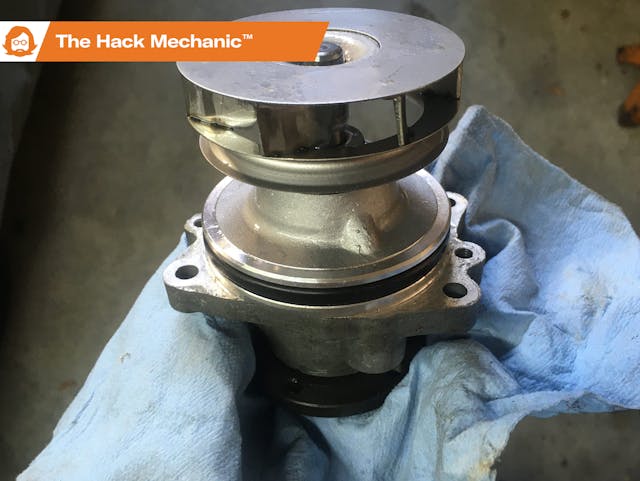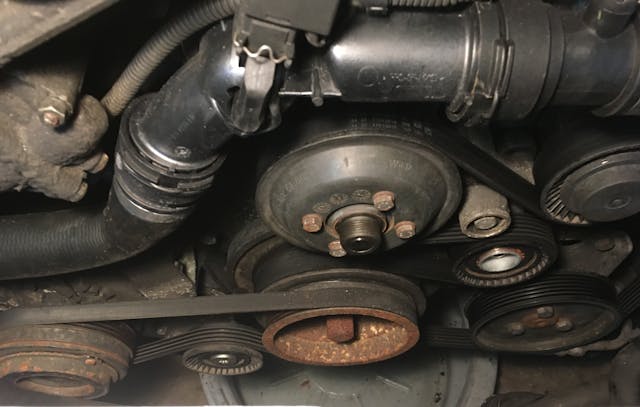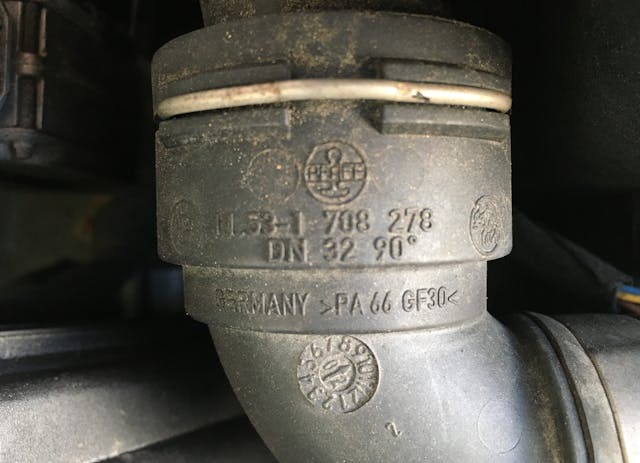When it comes to old cars, aftermarket parts can be a crapshoot

Back in 2019, I wrote a piece about replacement parts, detailing the differences between what was on the car when it was new, Genuine/Original Equipment (OE) parts you buy at the dealer, Original Equipment Manufacturer (OEM), aftermarket, and New Old Stock (NOS). Then, this past summer, I wrote a few stories about chasing reliability—doing some preventive maintenance on my daily driver BMW E39 530i Sport and my little Winnebago Rialta RV and making decisions about replacing parts that hadn’t actually broken.
Well, one of those decisions bit me.
Beginning sometime in the 1990s, BMW became notorious for its time-bomb cooling systems. The all-metal cooling systems of yore were gone, replaced by radiators with plastic side or top tanks, plastic expansion tanks, plastic thermostat housings, water pumps with a plastic (well, composite resin) impeller on the shaft, and hoses with plastic snap-on ends. Age, heat, and vibration eventually cause all this plastic to crack, causing coolant loss, leading to rapid engine overheating. On any car, driving with the temperature in the red can cause the head to warp or crack, but a car such as my 530i with an inline six-cylinder engine and aluminum head is especially sensitive to overheating. Not only do you never drive it in the red, but you’re an idiot if you drive the car more than a few miles if there’s any known cooling system issue.
So, back in August, I gave the 530i’s cooling system a good look-over. When I found that the lower radiator hose was soft and pillow-y, I first ordered a replacement—a CarQuest-labed Gates hose on closeout from RockAuto. It was like 10 bucks shipped. I couldn’t resist. But then I thought better of it, and instead did the full-on, or mostly full-on, cooling system replacement.
I ordered the parts from FCP Euro, an independently owned European parts house in Connecticut which provides a lifetime guarantee on all the parts it sells. Mind you, I don’t buy parts from these folks because of the guarantee—I’ve never filed a claim—but because their prices are quite good; they have a good website that clearly shows the different OE, OEM, and aftermarket choices they offer; and the parts usually arrive in a day or two. Most of the cooling system parts were bundled together in an “OE Supplier BMW Cooling System Overhaul Kit.” The “OE” doesn’t mean that every part in the kit is the OE part, but that the manufacturers selected are all OE/OEM suppliers to BMW. For example, the coolant and the level sensor in the kit were Genuine BMW, the water pump was from the German supplier Hepu and has a metal impeller instead of a plastic one, the expansion tank Mahle/Behr, the hoses Rein, etc. Other parts I ordered from FCP to complete what I needed were aftermarket. The radiator, for example, is a Nissens. They’re an OEM to other manufacturers, but not to BMW. You could, of course, order everything as Genuine BMW, but it would easily total twice the cost, and the cost, along with other while-you’re-in-there items, neared $500. For replacement of a cooling system that had nothing demonstrably wrong with it. Really, I was buying peace of mind, which considering what happened, is howlingly funny.
When the kit arrived and I began pulling my cooling system apart and looked at the date codes, I found that the water pump had already been replaced with some unbranded part, but all the other cooling system parts were still original, wearing the BMW stamp and a 2003 date code. I installed the new parts, felt insufferably pleased with myself for defusing the cooling system time bomb, and officially declared that I’d no longer opt for taking my wife’s much-newer, much-lower-mileage 2013 Honda Fit if we were driving out of town.

Then, sometime in early fall while I was driving the 530i, a warning of low coolant level came on the dashboard display. The temperature gauge was still reading in the middle, and I was only a few miles from home, but I stopped, opened the hood, didn’t see steam or smell coolant. I looked beneath the car and didn’t see coolant dripping from beneath the engine. So I drove the rest of the way. After I got home and let the car cool, I opened up the cap on the expansion tank and saw that the “bobber” sensor was indeed down inside the neck of the tank. I still had most of a gallon jug of proper BMW coolant mixed with distilled water left over from the parts installation, so I topped the expansion tank off. It was surprised that it took nearly a quart, but since I saw no evidence of leakage, I assumed that maybe I hadn’t completely bled the air out of the system. I continued to use the car.
All was fine until a few weeks ago. In early in December, the low coolant message came on again. Ironically, I was on my way to give a talk at the Larz Anderson Auto Museum in Brookline, Massachusetts, and one of the topics was my oft-repeated “Big Seven” things that cause a car to die, one of which is cooling system problems. I again sniffed for coolant, verified that there wasn’t a mini-Niagara gushing forth from under the car, and watched the temperature gauge like a hawk as I drove the few miles to the talk, then back home. I found that the car was again down nearly a quart of coolant.
I did a more thorough investigation, jacking the car up and setting it on stands, and this time, I saw something of an oozing gun—wetness around the hole at the low point of the engine under-cover.

I pulled off the cover and found coolant on the bottom of the engine and on the power steering hoses.

So, just to be completely clear about this, I’d taken a car with absolutely no cooling system problems whatsoever and, in the name of preventive maintenance, had installed $500 worth of new cooling system parts—purchased from a reputable vendor. Yet I had now a car with a leaking cooling system. Plus, it was now winter, the roads had already been salted, and making space to work in my garage required kicking out my Lotus Europa or my BMW 3.0CSi and into the driveway. Great. Just freaking great.
On virtually any modern car, things are packed in so tightly that it can be challenging to identify the source of a small coolant leak, and the BMW E39 is no different. The fan shroud and fan are jammed up against the front of the engine. Although it’s not trivial, those can be pulled off without dumping the coolant, but even still, the pulleys and serpentine belt make it difficult to see the actual water pump mating flange.

I’d bought a Stant cooling system pressure-tester a few years back when I was sorting out the Lotus and had the foresight to also buy the special adapter needed to use it on the BMW E39’s expansion tank. I pressurized it to about 75 percent of the cap’s 2 bar (20 psi) rating. At first, it seemed to hold pressure, but over the next few minutes, it slowly dropped. I crawled under the car and saw small rivulets of coolant running down the front of the block.

The leak had to be coming from either the thermostat or the water pump, both of which have o-ring seals rather than gaskets, and thus can leak if there’s corrosion on the mating surface. I cleaned everything off, pressurized again, felt for wetness, and isolated the leak to the water pump. The only question was whether it was seeping past the o-ring seal between the housing pump and the block, or out the shaft or the weep hole, and it was difficult to lay eyeballs on these spots. Finally, using a mirror, I was able to see the drips forming on the boss beneath the weep hole. But still, it was possible that they were dripping down there from the top.
I’ve written a lot about what I call “the rhythm of repair,” which is the dynamic where it’s always preferable to have a replacement part in hand before you take a car “down” and out of service, but on the other hand, at times you can’t really be certain of what’s wrong until you pull things apart. Although I hated to sideline the daily driver, I had little choice. I slid the catch basin beneath the engine, undid the serpentine belt, and removed the water pump. With it in my hand, I could see where blue gel had congealed in the little pressed-in cap. Clearly, coolant had been dripping down there from the weep hole above it.

I had a bad water pump.
This was surprising for a number of reasons.
First, I’d only put about 600 miles on the car since the pump was installed in August.
Second, since the car had lost coolant not once but twice, it’s likely the pump had been leaking since day one.
Third, this wasn’t some cheap unbranded Chinese-made eBay water pump. Hepu is generally regarded as a good brand, the pump was stamped “Made in Germany,” and it was bought from FCP Euro, a company that, since it guarantees all parts for life, tries to avoid selling junk.
I posted all this on my Facebook page and got a hail of responses. I am not a pro, but I have friends who are. Two professional mechanics whose opinions I value said that they only buy the genuine BMW water pump (about $135) or its OEM counterpart from Salieri (about $46). Both of these pumps have resin impellers. I was quite surprised by this, as enthusiast forums are filled with posts proselytizing that, when replacing the water pump, you always use one with a metal impeller. However, it was explained to me that one reason for the resin impeller is that, if the impeller grenades, it doesn’t carve up the inside of the aluminum engine block. In addition, I was warned that the extra weight of the metal impeller can create balance issues on the shaft, which in turn can put stress on the bearing and cause the shaft seal to leak.
So, I called FCP. A sales agent spent quite a bit of time with me on the phone. I asked for the return numbers on the Hepu pump. The agent said that they’d had about 30 sent back the last year. That sounded like a lot. Then he said that that was out of about 5000 sold. So, less than 1 percent. I asked about the OEM Salieri pump and was told that the sales and return numbers were quite similar to the Hepi. I returned the leaking Hepu and ordered the Salieri, even though the customer reviews on the FCP website included one report of a sheared impeller on the Salieri.
When the Salieri pump—reportedly the OEM equivalent of the Genuine BMW part, and reportedly the same thing but without the BMW logo on it—arrived, I unpacked it and found that, although the box says “Made in Italy,” the resin impeller says “Czech Republic” (not that there’s necessarily anything wrong with that). And, while the date code on the impeller is 2019, the one on the body of the pump is 2014. So, who knows what it is.


But that’s not the end of the story.
Installing the Salieri water pump took just a few minutes (and yes, I installed it rather than second-guessing the date codes and sending it back, as I need the daily driver to be just that—and I need the weather-sensitive cars back in the garage). Buttoning up the rest of the cooling system took longer, as the fan shroud and the coolant expansion tank on this car are like one of those interlocking Chinese puzzles. Fortunately, I never had to remove the radiator, so it was still about half-full of coolant. But at some point, while trying to make sure the tabs on the fan shroud were properly inserted in the little slots on the radiator, I crawled under the car and wiggled things around. When I did, coolant began streaming out the connection from the radiator to the lower hose. Not dripping—streaming.
As I mentioned earlier, most of the coolant hoses on this car aren’t attached to their fittings with hose clamps. Instead, the hoses have plastic ends integrated into them. These ends have a slot that lines up with a ridge in whatever they’re mating to, a clip that locks them in place, and an o-ring inside which seals against a beveled surface. I found that, if I just slightly tugged on the plastic fitting of the lower radiator hose, coolant streamed out. It largely stopped when I let go. And, there was a surprising amount of play in the fitting, as if it wasn’t as locked on as it’s supposed to be. So, it seemed likely that the fitting on the hose was cracked, or the fitting at the bottom of the radiator was cracked. Whether this had anything to do with the coolant loss, I did not know, but it was certainly leaking now.

I had little choice but to pull off the hose, so I positioned the basin beneath it and caught the coolant. I inspected the plastic fittings on both the hose and the radiator. Neither appeared cracked. I checked that the rubber o-ring inside was present and not gashed. The o-ring did seem a bit flat, but that’s not surprising considering that it had been compressed in place for months. Damn, I thought—I’m going to have to order another hose, and if that doesn’t work, another radiator. I suppose it’s better that this is happening now than when there’s a foot of snow on the ground and the garage is inaccessible, but hokum smokum, it sure would’ve been preferable for this to rear its head in the summer or fall.
And then I remembered that I still had that $10 CarQuest-branded Gates hose I’d ordered from RockAuto before I decided to do the whole cooling system. I miraculously found it in my entropic garage and snapped it into place, then filled the system with coolant and tugged the hose. No leaks. I drove the car. So far so good.
The point of all of this is that it’s getting more and more challenging simply keeping old cars running reliably, and I don’t even consider a 2003 BMW 530i to be an “old car.” When cars are new and still under warrantee, the manufacturer has incentive to provide parts that keep warrantee claims to a minimum, but once the cars age out of the warrantee window, all bets are off, everywhere. There’s no guarantee that the part that you pay top dollar for at the dealer is the same as what was on the car when it was new. There’s no guarantee that the OEM version of that part has gone through the same quality control testing as the “genuine” OE part. And if the part is aftermarket rather than OE or OEM, you’re on your own. You can read opinions on user forums, or poll your friends, or look at ratings on sites like Amazon and FCP Euro, but it’s just a crapshoot.
I still think that prophylactically replacing the entire cooling system was the correct thing to do to this 200,000-mile BMW if I intend to keep daily-driving it. I think that getting a Hepu pump that likely wept from day one was largely just a bad draw of the cards. I’m still processing the fact that the Rein hose wouldn’t hold its snap-fit onto the Nissens radiator. If the lesson there is that all of these parts need to be Genuine BMW (and I’m not at all certain that it is), I’m not sure I can continue to afford to drive this car.
More than that, for 35 years my buying habits have been predicated on the idea that I don’t need a new car or a five-year-old car because I can make nearly any car as dependable as it needs to be via preventative maintenance applied to “The Big Seven.” Now I’m not so sure.
As you can guess, my wife and I drove her Honda Fit to Christmas dinner with her family after all.
***
Rob Siegel’s new book, The Best of the Hack MechanicTM: 35 years of hacks, kluges, and assorted automotive mayhem, is available on Amazon. His other seven books are available here, or you can order personally-inscribed copies through his website, www.robsiegel.com.

